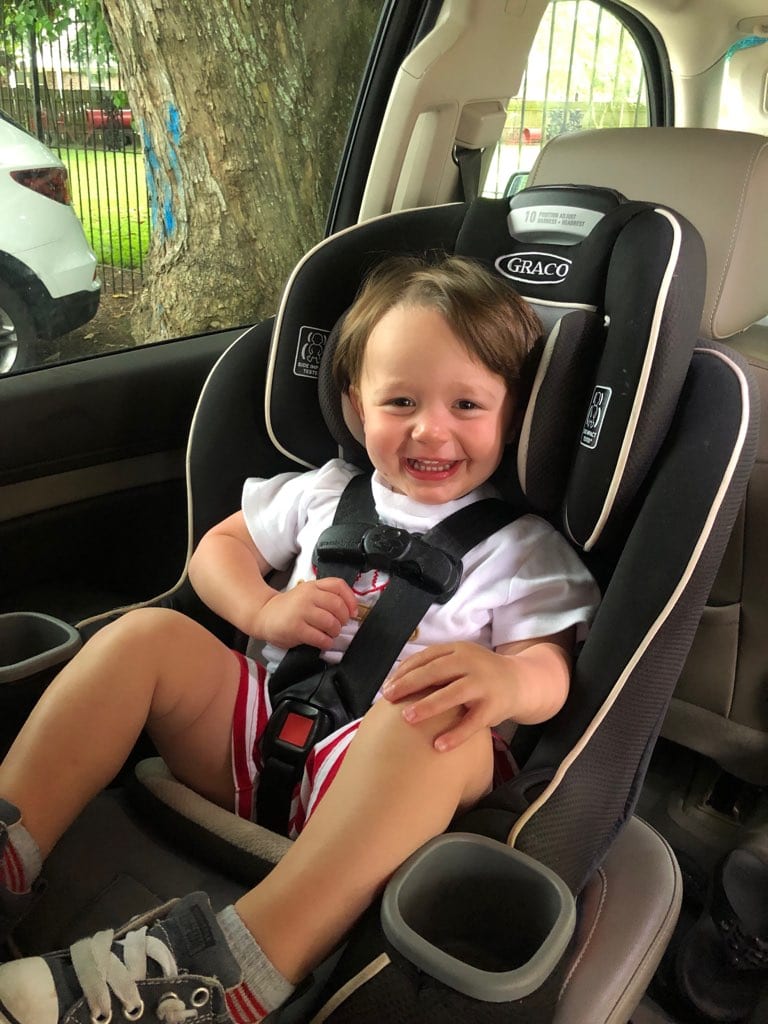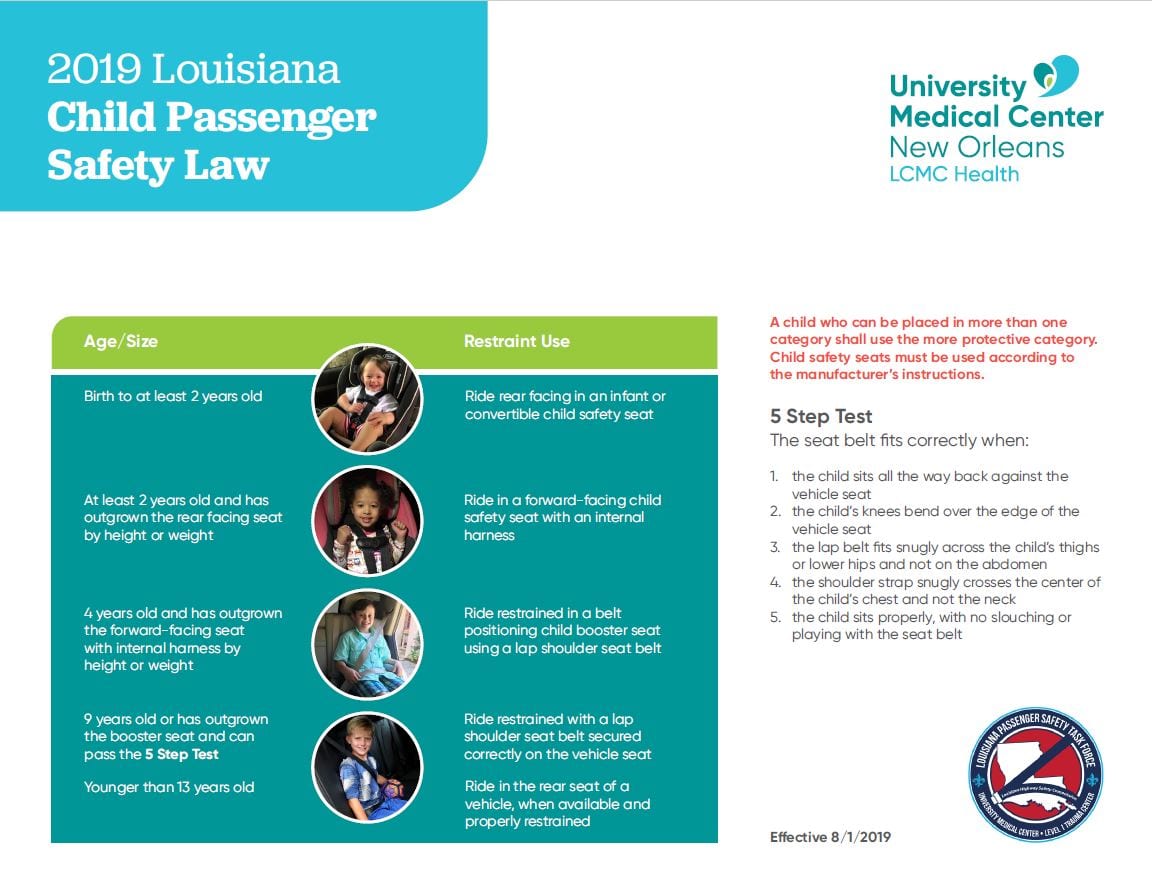Disclosure :: this post is sponsored by University Medical Center.
What You Need to Know About the New Child Safety Seat Law
Preparing your children to return to school can be a little hectic. Your children may still want to enjoy their last bit of fun in the sun or avoiding the New Orleans heat while you are focused on ensuring that they are prepared to have an extraordinary school year by going through your massive to-do-list. As summer break rapidly comes to an end, be sure to add your children’s passenger safety to your checklist of things to do to prepare for school.
You’ve ordered new, larger school uniforms and shoes, conquered the school supply list, found the perfect school bag and made it through a fresh haircut, but did you adjust your children’s safety seats following their 2-inch growth during the summer? Are you in compliance with the upgraded child safety seat law?
 Effective August 1, 2019, a new child safety seat law will be enforced in the state of Louisiana.
Effective August 1, 2019, a new child safety seat law will be enforced in the state of Louisiana.
The Community Injury Prevention Program at University Medical Center New Orleans championed the legislation this session by securing the support of the Louisiana Chapter of the American Academy of Pediatrics and the Louisiana Chapter of the American College of Surgeons. The amended law passed unanimously, as it mirrors the best practice standards set forth by the American Academy of Pediatrics.
The Academy upgraded its best practice standards in 2011; however, the Louisiana child safety seat law had not been upgraded in more than 15 years. Fatigued by witnessing the number of preventable injuries and fatalities, University Medical Center’s Injury Prevention team took the opportunity to make a change to better the outcome in motor vehicle crashes. Lessening the amount of injuries and fatalities will assist in creating a healthier future for the state we all love.
 Following best practice standards for child seat safety and the new Louisiana child passenger restraint law will have an invaluable impact on lessening the risk of injury or a fatal outcome when involved in a crash. We ask that you use the seat that you currently have according to the manufacturer’s instructions and maximize the benefit of the safety features for the child safety seat. For example, if the rear facing harness weight can acquire a child until 40 pounds, then keep the child in the rear-facing mode until 40 pounds, if the child has not outgrown the seat by height. By doing so, you are maximizing the benefit of rear facing, which we know is the safest mode of travel.
Following best practice standards for child seat safety and the new Louisiana child passenger restraint law will have an invaluable impact on lessening the risk of injury or a fatal outcome when involved in a crash. We ask that you use the seat that you currently have according to the manufacturer’s instructions and maximize the benefit of the safety features for the child safety seat. For example, if the rear facing harness weight can acquire a child until 40 pounds, then keep the child in the rear-facing mode until 40 pounds, if the child has not outgrown the seat by height. By doing so, you are maximizing the benefit of rear facing, which we know is the safest mode of travel.
Usually when you transition from one thing to another, the transition is beneficial, but with child safety seats you lose protection each time you transition. Parents transitioning to the next seat prematurely can complicate this transition. Before packing the car for the first day of school, let’s add child safety seats to the checklist:
| Age/Size | Restraint Use |
| Birth to at least 2 years old | Rear facing in an infant or convertible child safety seat |
| At least 2 years old and has outgrown the rear facing seat by height or weight | Ride in a forward-facing child safety seat with an internal harness |
| 4 years old and has outgrown the forward-facing seat with internal harness by height or weight | Rides restrained in a belt positioning child booster seat using a lap shoulder seat belt |
| 9 years old or has outgrown the booster seat and can pass the 5 Step Test* | Ride restrained with a lap shoulder seat belt secured correctly on the vehicle seat |
| Younger than 13 years old | Ride in the rear seat of a vehicle when available and properly restrained |
*The 5 Step Test allows you to know when the seat belt fits correctly when:
- The child sits all the way back against the vehicle seat
- The child’s knees bend over the edge of the vehicle seat
- The lap belt fits snugly across the child’s thighs or lower hips and not on the abdomen
- The shoulder strap snugly crosses the center of the child’s chest and not the neck
- The child sits properly, with no slouching or playing with the seat belt
Here’s a graphic to download as a helpful reminder for yourself and to share with your friends who are also parents.
 University Medical Center leads the Louisiana Passenger Safety Task Force, a cohesive network of over 700 child passenger safety technicians in Louisiana. To assist with child safety seat questions and compliance, University Medical Center has opened 4 landlines staffed by Nationally Certified Child Passenger Safety Instructors:
University Medical Center leads the Louisiana Passenger Safety Task Force, a cohesive network of over 700 child passenger safety technicians in Louisiana. To assist with child safety seat questions and compliance, University Medical Center has opened 4 landlines staffed by Nationally Certified Child Passenger Safety Instructors:
504.702.2296
504.702.2264
504.702.2295
504.702.2062
A large majority of your time will be spent preparing for the upcoming school year, but you must understand that the most dangerous thing that you do daily is drive or ride as a passenger in a motor vehicle and therefore the safety of your family while riding in the car should be on your list of priorities always. The Louisiana Passenger Safety Task Force has over 105 fitting stations, free of cost to the community. To locate a fitting station near you, please visit umcno.org/injuryprevention or Buckle Up Louisiana on Facebook.
About Bridget Gardner, RN
 Bridget Gardner, RN, is a registered nurse and coordinator of the Community Injury Prevention Program at University Medical Center New Orleans. The Louisiana Passenger Safety Task Force is a network of certified child passenger safety technicians throughout the state, directed by the University Medical Center Trauma Program.
Bridget Gardner, RN, is a registered nurse and coordinator of the Community Injury Prevention Program at University Medical Center New Orleans. The Louisiana Passenger Safety Task Force is a network of certified child passenger safety technicians throughout the state, directed by the University Medical Center Trauma Program.
















Hi Bridget! GREAT Article about something that has been needed for a LONG time. I was wondering if the word REAR was missing from your table that you posted? In the Restraint Use column of the non-colorful chart it is missing where it is in the colorful chart. I am not trying to nit pick but the more we can get the message across that children under 2 NEED to be REAR facing, the better! Thanks for helping get the message out for our children!